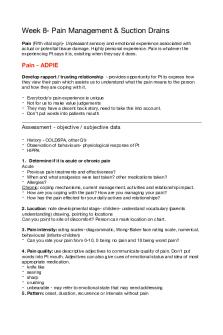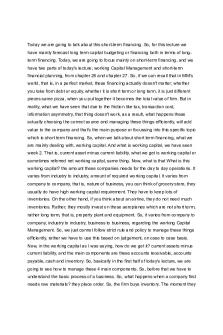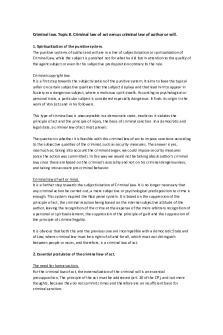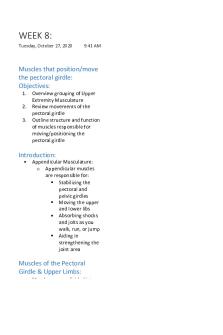A&PII Chpt 8 - Lecture notes 8 PDF

| Title | A&PII Chpt 8 - Lecture notes 8 |
|---|---|
| Course | Anatomy And Physiology Ii |
| Institution | DePaul University |
| Pages | 5 |
| File Size | 51.4 KB |
| File Type | |
| Total Downloads | 25 |
| Total Views | 156 |
Summary
A&PII Chpt 8 - Lecture notes 8...
Description
Section Eight Enunciations Joint-resource between bones o Immovable o Moveable-consider exceptionally complex movement, however compromise strength. Joints are ordered utilizing a primary or utilitarian plan. o Functional grouping named by level of development permitted: Synarthroses-steady joint. Amphiarthroses-marginally versatile Diarthroses-unreservedly portable o Structural characterization named by substance that ties the bones together. Sinewy CT-most are synarthroses. - Most sinewy joints are undaunted (synarthroses). How much development relies upon the length of the filaments. Syndesmoses, as that between the span and ulna, rabbit moderately long fiber and are named amphiarthroses by some anatomist. Cartilagenous Hard - Hard joints are undaunted (synarthroses), these happen when bone sections meld like in the plates of the skull or epiphyseal plate of long bone. While juvenile, these joints are normally filled with a sinewy CT or ligament yet as the skeleton develops, these tissues are supplanted with bone. Synovial-liquid occupied joint space; all are diarthroses. Three kinds of Fibrous Joints Stitch joint kept intact with extremely short interconnecting strands, and bone edges interlocked. Tracked down just in the skull. o Found distinctly in skull; toothlike stringy CT projections from nearby bones that interlock with one another. Syndesmosis-joint kept intact by a short tendon. Stringy issue can change long however, is longer than in stitches. Gomphosis-"stake in attachment" stringy joint. Periodontal tendon holds tooth in attachment. o Peg and attachment joint that happens just between base of a tooth and the alveolar cycles of the mandible or maxilla. o The stringy tendons of the gomhosis that attach the tooth to the attachment are called the periodontal tendons. Hard Joints Synostosis-hard combination of two bones; these frequently begin as stringy CT or ligament joints first. o Occurs when stitches and epiphyseal plate are shut by bone o Some characterize these as a fourth kind of joint since the material melding the bones is bone rather than a sinewy CT. Two Types of Cartilaginous Joints
Synchrondroses-hyaline ligament joins bone. Symphyses-fibrocartilage interfaces two bones. o Designed for strength with little give. o Can be amphiarhroses or synarthoses. Cartilagenous joints can be amphiarthroses or synarthoses. Symphyses are intended for strength and adaptability. The epiphyseal plate is a transitory synchondroses. It will supplant by bone and become a synostosis. The first costochondral intersection permits a few development among ribs and sternum. The other costchondral intersections are synovial joints (which need synovial layers). Synovial Joints Diathroses-uninhibitedly portable joints. Parts of synovial joints o Articular ligament hyaline ligament covering articular surfaces of bones. o Joint container sleevelike packaging around closures of bones, restricting them together, the external piece is continuation of the periosteum. o Synovial liquid o Synovial film lines joint container; secretes synovial liquid. Capacity of Synovial Joint Fluid Disperses pressure powers across articular surfaces and outward to joint case. Shock retention. Oil Supplement dispersion o "Sobbing oil"- pressure on the joint powers the joint liquid out of the grid of the articular hyaline ligament; when the pressure is delivered the liquid is drawn once again into the grid from the joint space. Created as a filtrate of blood by the synovial layer. The piece of synovial is like the ground substance of free connective tissue. The cells of the synovial film emit hyaluronic corrosive into the liquid, which expands the thickness and grease properties of joint liquid. Adornment Structures of Synovial Joints Menisci-stack of fibrocartilage situated between articulating bones; pads sway among bones and expands the fit between articulating bones. Additionally called 'articular plates'. Tendons solid strings of thick, sinewy tissue that hold unresolved issue and extension the synovial joint in this way adding support. o Extracapsular tendon o Intracapsular tendon Fat cushions Bursae-straightened sac of synovial liquid; gives a pad that diminishes rubbing and pressure where tendon and ligaments disregard boney prominences. Ligament sheaths-prolonged bursae that fold over a ligament. Factors that Help Stabilize Synovial Joints Tendons
Muscle ligaments cross the joint and go about as a settling power State of the articulating surfaces can limit development. Kinds of Synovial Joints Skimming joint o Acromioclavicular and claviculosternal joints o Intercarpal and intertarsal joints o Vertebrocostal joints o Sacro-iliac joints Pivot joint o Elbow joints o Knee joints o Ankle joints o Interphalangeal joints Turn joint o Atlas/pivot o Proximal radio-ulnar joints Ellipsoid joint o Radiocarpal joints o Metacarpophalangeal joints 2-5 o Metatarsophalangeal joints Saddle joint o First carpometacarpal joints Ball-and-attachment joint o Shoulder joints o Hip joints Precise Movements Flexion-diminishes the point between bones in foremost back plane. Augmentation expands the point between bones. Hyperextension-extending and broadening part past its physical position. Parallel flexion Dorsiflexion (lower leg flexion)- up development of the foot through flexion at the lower leg. Plantar flexion (lower leg expansion)- toe pointing. Kidnapping and Adduction Kidnapping development away from the midline of the body, as seen in physical position. Adduction-development toward the hub or midline of the body, as seen in the physical position. Roundabout Movements Roundabout developments bend like development around a pivot. Turn turning a bone on its own pivot ("no" movement of the head) o Medial revolution turning the front surface of the appendage towards the body, o Lateral revolution converse of average pivot; turning the appendage back to anatomic position Circumduction-moves a section so that its distal end moves all around.
Supination-turns the hand palm side anteriorly Pronation-turns the hand palm side posteriorly. Extraordinary Movements Resistance thumb to fingertip. Withdrawal moves a section in reverse Protraction-pushes a section ahead Eversion-turning underside of the foot outward. Reversal turning underside of foot internal. Misery brings down a section. Height moves a section up. Select Synovial Joints Glenohumeral or Humeroscapular (shoulder) joint o Ball-and-attachment o Most portable joint in view of the shallowness of the glenoid hole. o Highly versatile joint that permits circumduction. o Relatively powerless joint. Glenohumeral o Structures that fortify the shoulder joint are ligaments of the rotator sleeve, tendons, muscles, and bursae. o Glenoid labrum-restricted edge of fibrocartilage around glenoid pit that leads profundity to the pit. o Ligaments settling the shoulder Coracoclavicular tendons Acromioclavicular tendon Coracoacromial tendon Coracohumeral tendon Glenohumeral tendons Coxal joint (hip) o Stable ball-and-attachment joint head of femur sits into the hip bone socket o A joint container and tendons add to joint's solidness o Also upheld by huge bulks o The neck of the femur is bound to break than disjoin. Tibiofemoral and Femoropatellar joint (knee) o Tibiofemoral joint is perhaps the most complicated and most often harmed joint Licenses flexion and expansion. Also with knee flexed, some interior and outside revolution. o Femoropatellar joint is the enunciation of the knee cap (patella) with the femur. o Major tendons of the knee joint Patellar tendon - The average and sidelong retinacula converge with the joint container and like the patella tendon are a continuation of the ligament of the quadriceps. Fibular and tibial guarantee tendons - Fibular and tibial security tendons are likewise alluded to as the
average and sidelong insurance tendons. Front and back cruciate tendons - Front cruciate tendon joins to the foremost part of the intercondylar are of the tibia and passes posteriorly to connect to the parallel condyle of the femur. It helps really look at hyperextension of the knee. - Back cruciate tendon joins to the back part of the intercondylar region of the tibia and passes anteriorly to join to the average condyle of the femur. This tendon forestalls back dislodging of the tibia (or front relocation of the femur). Menisci-fibrocartilage cushions between the femur and the tibia. The average meniscus is melded with the tibial (average) security tendon. Wounds delivered by focused on put on the sidelong part of the knee will generally tear the tibial guarantee tendon, average meniscus and foremost cruciate tendon. Maturing and Articulations More established grown-ups o Decrease in the scope of movement (ROM) of the joints related with decline versatility of the tendon and boney changes close to the joints. Changes in walk happen because of reduction ROM and muscle shortcoming Skeletal illnesses manifest as joint issues o Arthritis-harm to ligament surfaces. o Abnormal bone development (lipping)- impacts joint movement....
Similar Free PDFs

A&PII Chpt 8 - Lecture notes 8
- 5 Pages

Cams chpt 8 - notes
- 87 Pages

8 - Lecture notes 8
- 21 Pages

8 - Lecture notes 8
- 21 Pages

8 Midwifery - Lecture notes 8
- 3 Pages

Taxation 8 - Lecture notes 8
- 2 Pages

Week 8 - Lecture notes 8
- 6 Pages

Dox 8 - Lecture notes 8
- 21 Pages

Lesson 8 - Lecture notes 8
- 2 Pages

Assignment 8 - Lecture notes 8
- 4 Pages

Week 8 - Lecture notes 8
- 23 Pages

WEEK 8 - Lecture notes 8
- 10 Pages

CL-8 - Lecture notes 8
- 12 Pages

Tema 8 - Lecture notes 8
- 8 Pages

Lesson 8 - Lecture notes 8
- 19 Pages

Chapter 8 - Lecture notes 8
- 7 Pages
Popular Institutions
- Tinajero National High School - Annex
- Politeknik Caltex Riau
- Yokohama City University
- SGT University
- University of Al-Qadisiyah
- Divine Word College of Vigan
- Techniek College Rotterdam
- Universidade de Santiago
- Universiti Teknologi MARA Cawangan Johor Kampus Pasir Gudang
- Poltekkes Kemenkes Yogyakarta
- Baguio City National High School
- Colegio san marcos
- preparatoria uno
- Centro de Bachillerato Tecnológico Industrial y de Servicios No. 107
- Dalian Maritime University
- Quang Trung Secondary School
- Colegio Tecnológico en Informática
- Corporación Regional de Educación Superior
- Grupo CEDVA
- Dar Al Uloom University
- Centro de Estudios Preuniversitarios de la Universidad Nacional de Ingeniería
- 上智大学
- Aakash International School, Nuna Majara
- San Felipe Neri Catholic School
- Kang Chiao International School - New Taipei City
- Misamis Occidental National High School
- Institución Educativa Escuela Normal Juan Ladrilleros
- Kolehiyo ng Pantukan
- Batanes State College
- Instituto Continental
- Sekolah Menengah Kejuruan Kesehatan Kaltara (Tarakan)
- Colegio de La Inmaculada Concepcion - Cebu